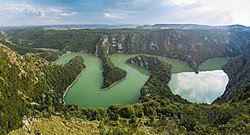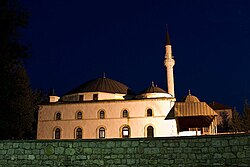Sjenica
|
Sjenica Сјеница |
||||
|---|---|---|---|---|
| Town and municipality | ||||
From top: Uvac Special Nature Reserve, Sjenica Mosque at night
|
||||
|
||||
 Location of the municipality of Sjenica within Serbia |
||||
| Coordinates: 43°16′N 20°00′E / 43.267°N 20.000°ECoordinates: 43°16′N 20°00′E / 43.267°N 20.000°E | ||||
| Country |
|
|||
| Region | Šumadija and Western Serbia | |||
| District | Zlatibor | |||
| First mentioned | 1253 | |||
| Settlements | 101 | |||
| Government | ||||
| • Mayor | Hazbo Mujović (SDA) | |||
| Area | ||||
| Area rank | 11th | |||
| • Municipality | 1,059 km2 (409 sq mi) | |||
| Elevation | 1,026 m (3,366 ft) | |||
| Population (2011 census) | ||||
| • Rank | 65th | |||
| • Town | 14,060 | |||
| • Municipality | 26,392 | |||
| Time zone | CET (UTC+1) | |||
| • Summer (DST) | CEST (UTC+2) | |||
| Postal code | 36310 | |||
| Area code | +381 20 | |||
| Car plates | SJ | |||
| Website | www |
|||
Sjenica (Serbian Cyrillic: Сјеница; pronounced [sjɛ̌nitsa]), is a town and municipality located in the Zlatibor District of the western Serbia. The population of the town, according to 2011 census, is 14,060 inhabitants, while the municipality has 26,392.
Sjenica is situated in the Pešter plateau, and is surrounded by the mountains of Jadovnik, Ozren, Giljeva and Javor.
It is an old town, first mentioned in 1253 AD as a place where many merchants rested and paid taxes while on their way to Dubrovnik.Voivode Stefan Vasoje, the son of King Stefan Konstantin (r. 1321-1322), received Sjenica as an appanage by Emperor Stefan Dušan (r. 1331–1355). During the reign of the Ottoman Empire, Sjenica was used as a fortified site. On a nearby hill the Ottomans built a fortress, which was later demolished. Next to the fortress was a merchants' quarter and few wooden residential homes. In the 19th century, Sjenica was considered a high priority because of its political, military and strategic significance, thus many military campaigns were led during the First Serbian Uprising. Soon after, a new turmoil came to the region with a resistance movement against Sultan Mahmud II's reforms. During the Ottoman-Albanian hostilities of 1901 the town was partly burnt by Albanian bands. In the 1908-12 Ottoman parliament, the elected representative of Sjenica was Hasan Muhidin Bey (Hasan Muhedini), a local prominent Albanian.
In 1917 when the area was under Austrian control a conference was held, in which the representatives drafted and signed a resolution for the union of the area with Bosnia or the establishment of an autonomous region.
...
Wikipedia



